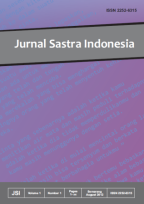Menghidupkan Alquran dari Perspektif Linguistik
##plugins.themes.academic_pro.article.main##
Abstract
Al-Qur'an adalah buku suci Muslim, sebuah buku yang diyakini sebagai ciptaan Allah SWT yang disampaikan kepada Nabi Muhammad, melalui mediasi malaikat Jibril. Ini berisi 114 surat, yang diterjemahkan ke dalam 6666 ayat, dan dibagi menjadi 30 juz. Banyak cara yang digunakan oleh manusia untuk memahami buku ini. Beberapa mencoba memahaminya dari pintu hukum, ilmu alam, ilmu sosial, dan sebagainya. Cara untuk memahami Al-Qur'an dari perspektif Linguistik memiliki keunikan yang tidak dimiliki disiplin lain dalam upaya yang sama. Dengan memahami Al-Qur'an dari perspektif Linguistik, diperoleh integritas wacana Alquran yang lebih komprehensif. Analisis wacana adalah metode yang digunakan untuk memahami perspektif Linguistik Alquran. Berbagai alat dalam bidang analisis wacana terlibat dalam upaya pemahaman ini. Secara garis besar, perangkat dibagi menjadi dua, yaitu teks Alquran itu sendiri dan konteks yang melekat. Teks Al-Qur'an melibatkan penguasaan bahasa Arab, sistematika Al-Qur'an "yang tidak sistematis", dan tahfidhul quran. Konteks yang melekat dalam teks-teks Al-Qur'an dapat disebutkan, misalnya asbabun nuzul, prinsip analogi, referensi dan inferensi wacana, dan koherensi. The Qur’an is a Muslim holy book, a book which is believed to be the creation of Allah SWT that was conveyed to the Prophet Muhammad, through the mediation of the angel Gabriel. It contains 114 chapters, which are translated into 6666 verses, and divided into 30 juz. Many ways are used by humans to understand this book. Some try to understand it from the law, natural sciences, social sciences, and others. The way to understand the Qur’an from a Linguistic perspective has the uniqueness that other disciplines do not have in the same effort. By understanding the Qur’an from a Linguistic perspective, it is obtained more comprehensive integrity of the Qur'anic discourse Discourse analysis is a method used to understand the Qur'an's Linguistic perspective. Various tools in the field of discourse analysis are involved in this understanding effort. Broadly speaking, the devices are divided into two, namely the Qur'anic text itself and the inherent context. The text of the Qur'an involves mastery of the Arabic language, the systematic of the Qur'an "which is not systematic", and tahfidhul quran. The context inherent in Qur'anic texts can be mentioned, for example asbabun nuzul, the principle of analogy, reference and discourse inference, and coherence.
